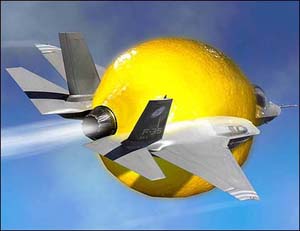 In retrospect, it was an insanely stupid idea to begin with.
In retrospect, it was an insanely stupid idea to begin with.
Hindsight is always 20/20.
The original concept was noble in its intent; a new fighter jet that would satisfy the needs of the Air Force, Navy and Marines. Better to develop one all-purpose fighter than have each branch go through the trouble and expense of manufacturing their own, right? And if one branch had a specific requirement, like the Navy needing stronger landing gear because of the stress put on the aircraft by carrier landings, then that could be taken care of after the fact.
Then they screwed the whole idea with the moronic notion that the newest, fastest, most brilliant state-of-the-art fighter in the world also had to serve as a helicopter.
Yes, you read that right.
For the first half of the story, watch this engaging Nova documentary on the battle between Boeing and Lockheed Martin over who would claim the prize. Both teams ran into serious delays, both teams overcame enormous hurdles, and both teams put together a truly awesome plane.
Both teams also deserve the Dunce of the Decade award for even considering such a preposterous notion that the fastest fighter jet in the world also had to serve as a friggin' chopper. If they had put their collective foot down and simply told the brass back in Washington "This is the stupidest idea we've ever heard of", maybe it would have dawned on someone that trying to make the fastest fighter jet in the world hover was the very definition of oxymoronic.
For your viewing pleasure: Battle of the X-Planes
Let's revisit a few lines from the documentary, shall we?
The plane for the 21st century, at least for the Air Force, would appear to be already here; the new F-22 Raptor, scheduled for deployment in 2005.
But the Raptor has a huge vulnerability the JSF Program must overcome; a giant price tag. Each plane costs about 100 million dollars.
So that is the JSF's mission impossible; to break the death spiral by coming up with a new fighter that costs a third of an F-22.
In other words, about $35 mil apiece.
Now, ten years later, for the second half of this story read this.
Last year, Pentagon leadership told Congress the acquisition price had increased another 16 per cent, from $328 billion to $379 billion for the 2,457 aircraft to be bought [$162 mil apiece]. Not to worry, however — they pledged to finally reverse the growth.
The result? This February, the price increased another 4 per cent to $395 billion and then even further in April. Don't expect the cost overruns to end there: The test program is only 20 per cent complete, the Government Accountability Office has reported, and the toughest tests are yet to come.
Hence the word 'debacle' in the post's title. Since we're dealing with the military, SNAFU would also work. In the past, when one branch of the service had a problem with one of its planes, at least the monetary damage was confined to just that one branch and plane.
Not so with the Joint Strike Fighter built by Lockheed Martin. From a goal of $35 mil apiece to — $162 mil and rising?
When they refer to the 'death spiral' up above...
The F-22 is just the latest example of a trend that goes back decades. Each new generation of fighters costs more than the last, so fewer are purchased. Ever more expensive fighters in ever decreasing numbers; in defense circles, that's known as the 'death spiral'.
But what no one predicted is that the date of the death spiral was going to arrive much sooner than expected. Ask yourself what aircraft did the damage in the last dozen headlines you've read that involved an aerial 'strike' against enemy combatants.
U.S. drone strike kills al-Qaeda chief in Yemen
U.S. drone strike kills 9 militants
American drone strike kills 8 in Pakistan
U.S. Drone Strike Kills 3 in Pakistan
US drone strike kills 6 militants in Pakistan
Ten killed by US drone strike in Pakistan
U.S. drone strike riles Pakistani politicians
US Drone Strikes Destabilize Pakistan
Ignoring Pakistan, US defends drone strikes
Obama aide: Drone strikes are legal, ethical
In the Face of CIA Drone Strikes, Pakistan is Powerless
The Year of the Drone
The booming drone industry — dominated by Boeing — thanks you, Lockheed Martin.
Well played.


 In retrospect, it was an insanely stupid idea to begin with.
In retrospect, it was an insanely stupid idea to begin with.